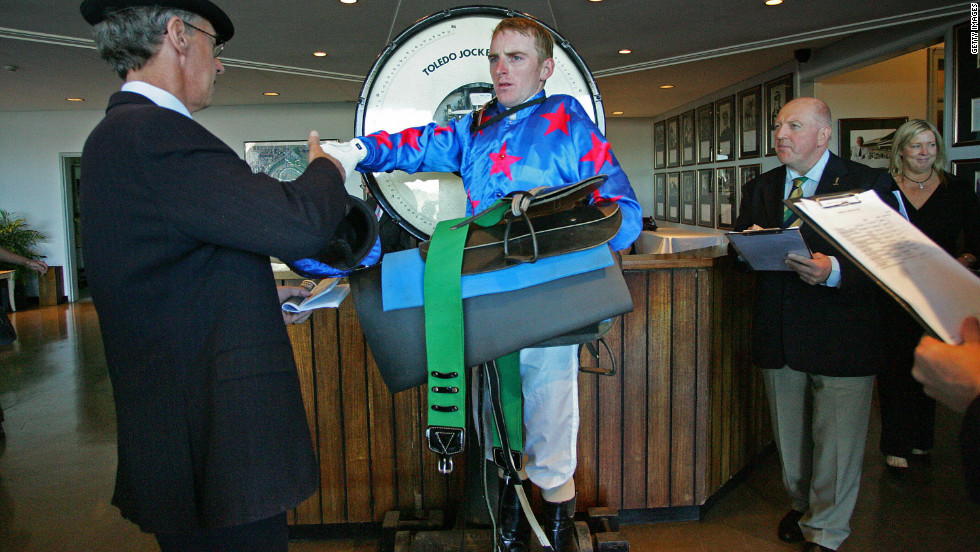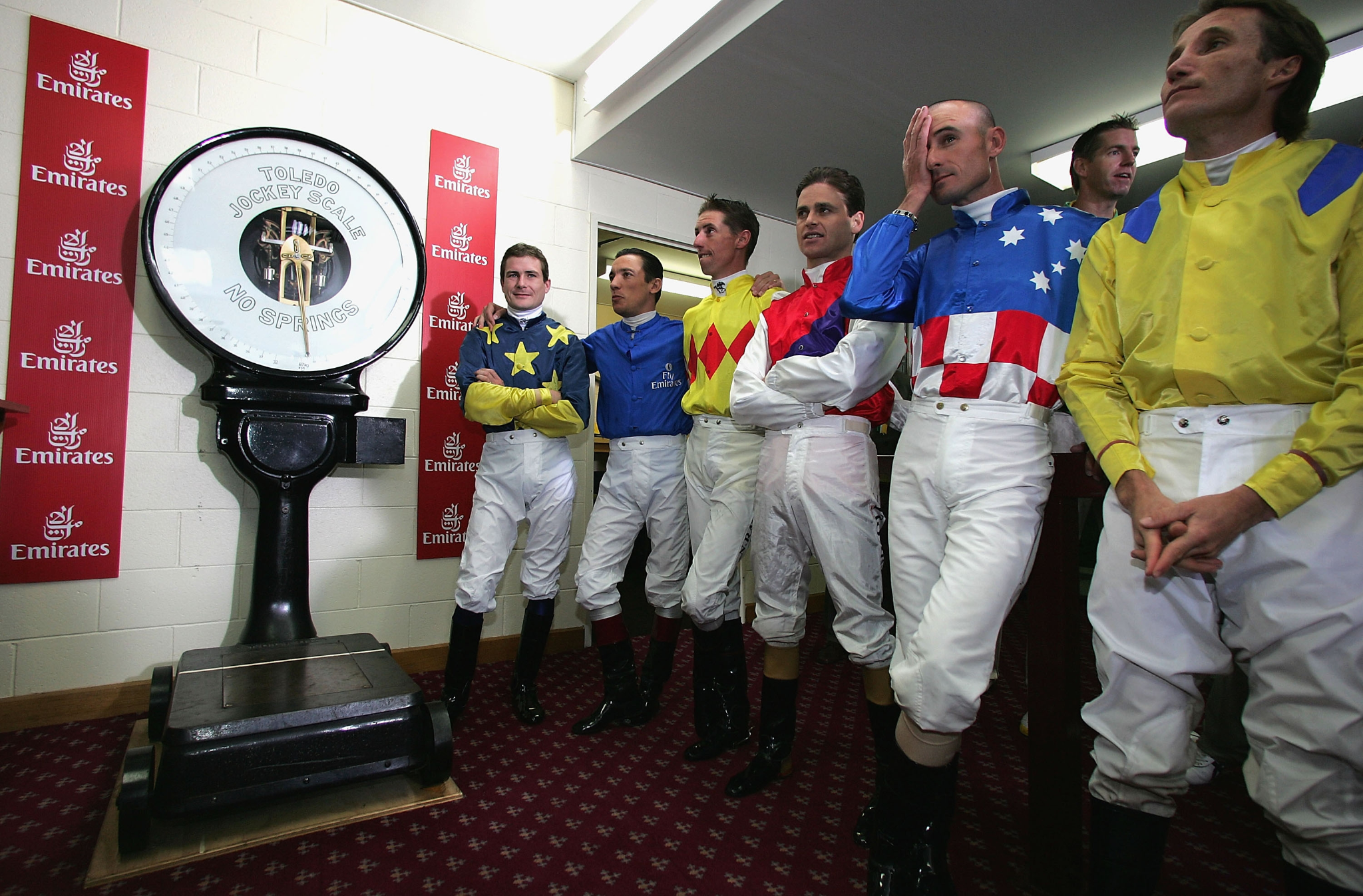As the two horses reach the 200-metre mark, the topweight ranges up to the bottom-weighted horse in the race, and they are poised to fight it out over the last 200 metres to determine the victor. Will the weight allotted to the race’s best-rated horse (the top weight) tell in the final strides, or will the lesser-rated horse with the lower weight finally surrender to the better-rated horse’s class?
This is a scenario that plays out on racetracks worldwide daily. While various other factors will determine the winner, the weight to be carried by each horse in the race and how that affects the running of a particular race will be top of mind for all punters when handicapping a race.
How do Jockeys get Weighed? Before a race, they should weigh themselves and their equipment (including the saddle) to ensure the correct weight. If a jockey weighs less than the horse, the discrepancy will be filled by tiny lead weights in a particular saddle material.
Traditional weighing scales with chairs were used to weigh jockeys, but mechanical scales have now taken their place. After weighing in, the jockey passes the saddle to the trainer or the trainer’s helper to saddle up the horse. Following the race, the rider must weigh in with all of his equipment to ensure that the horse carries the correct weight.
It is critical to comprehend the terminology. “Weighing out” refers to registering a rider’s weight before a race when they are outside of the jockeys’ room. “Weighing in” refers to the process of documenting their weight after the race as they make their way back inside.

The Clerk of Scales weighs the jockey. There is an official with the clerk of scales inside the jockeys’ chamber. Before racing starts, authorities must ensure that jockeys weigh and have their eight documented. The Cleark of Scales must visually check each jockey’s weight and report the information to the track officials. The officials then notify the commentator, who announces the overweight on any of their rides.
Weight and the Handicapper
With each passing year, the handicapper grows more accurate, perhaps making the work of the punter more difficult. Scrutinize the penalty carriers and try not to be discouraged by the weight increase, as the more significant the penalty, the closer the horse may be to the winners’ enclosure.
When a jockey declares an overweight on a horse, it is best to proceed with caution, although they should be evaluated for future races. Every race day, the impact of ‘weight’ on any horse is a hot subject of conversation. When a horse is said to be ‘well-weighted’ for a race, it is considered favourably handicapped compared to the weights allocated to its opponents.

If we take a comprehensive perspective, we may infer that a higher-class horse can carry heavier loads more quickly than a lower-quality galloper. However, as with everything else, this ability will be decided by the horse’s current racing condition, race distance, track condition (good, yielding, or heavy), and, of course, the all-important barrier position from which the horse leaps, particularly in large fields. A horse may be able to carry 60 kg over 1200m on a good or fast track, but over 1400m, it may only be able to carry 57 kg and win. The horse’s weight-carrying ability falls even more, when the track is wet.
Trainers like jockeys to be as near to the assigned weight as possible since it is more difficult for the horse to bear this than a person who can move with it. Most people are generally aware that jockeys are weighed both before and after a race to confirm they are carrying the weight listed in the program or on the changes list, but unless they have spent time in the jockeys’ room, you may not be familiar with the intricacies of the procedure.
Weight and the Trainer
Trainers seek to balance this component of form and weight by having an apprentice jockey ride the horse in a particular race. Apprentice jockeys are still in the learning phase of their jockeyship training and are permitted to ride horses in races for a fee.
In some instances, the weight decrease may compensate for the apprentice jockey’s lack of experience and, in some cases, skill. Consequently, while analyzing the relevance of an apprentice jockey’s claim, use care. However, some apprentices will always be better than others, and the lack of experience of these jockeys will not always hurt the horses’ chances of winning but rather increase them.
Addition of Weight to the Saddle
Certain races may require a horse to carry a bigger weight than the other horses in the race because some horses have higher ratings than others. The Clerk of Scales may add weight to a rider in various ways. Certain racecourses employ rubber cushions situated between the saddle towel and the saddle and weigh between one and ten pounds. Certain jockeys dislike those pads because they believe the smooth outside covering causes the saddle to slide. Therefore other racecourses allow lead weights, which are tucked into compartments beneath the saddle flap.

Most jockeys have three different saddles depending on the weight they require to carry. The heavier the saddle, the more weight they carry. Safety equipment like vests or helmets usually is not included against a rider’s weight.
Rider weights have always been contentious, with many riders lobbying for a greater minimum. Racing officials believe that fewer riders are going to harmful measures to lose weight than they were 15 years ago as the jockeys are being made aware of the harmful side effects. Many jockeys are also starting to comprehend how it will affect them after retiring.
Weight and the Form Analyst
The weight carried by a horse in a race will always be an essential factor in a Form Analyst’s or amateur handicapper’s race analysis. More information has been accessible to build studies as technology has advanced, which will make the analysis more accurate if utilized appropriately.
With the introduction of social media, this information has become even more easily accessible, thus enabling the Punter to modify their handicapping algorithms in real-time scenarios. If utilized consistently, the Form Studier will identify winners more often, which is the ultimate desire of all horse racing fans.

